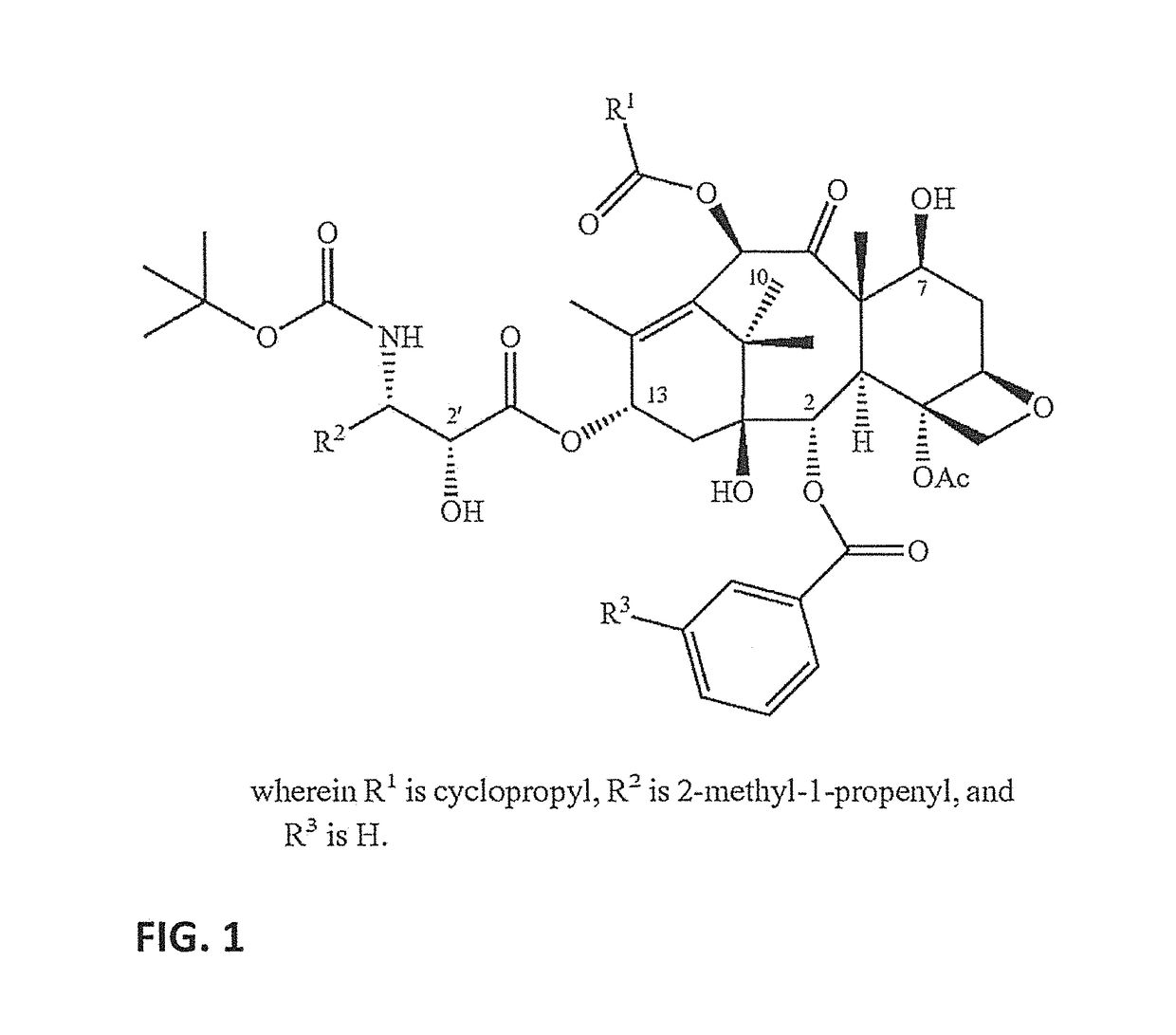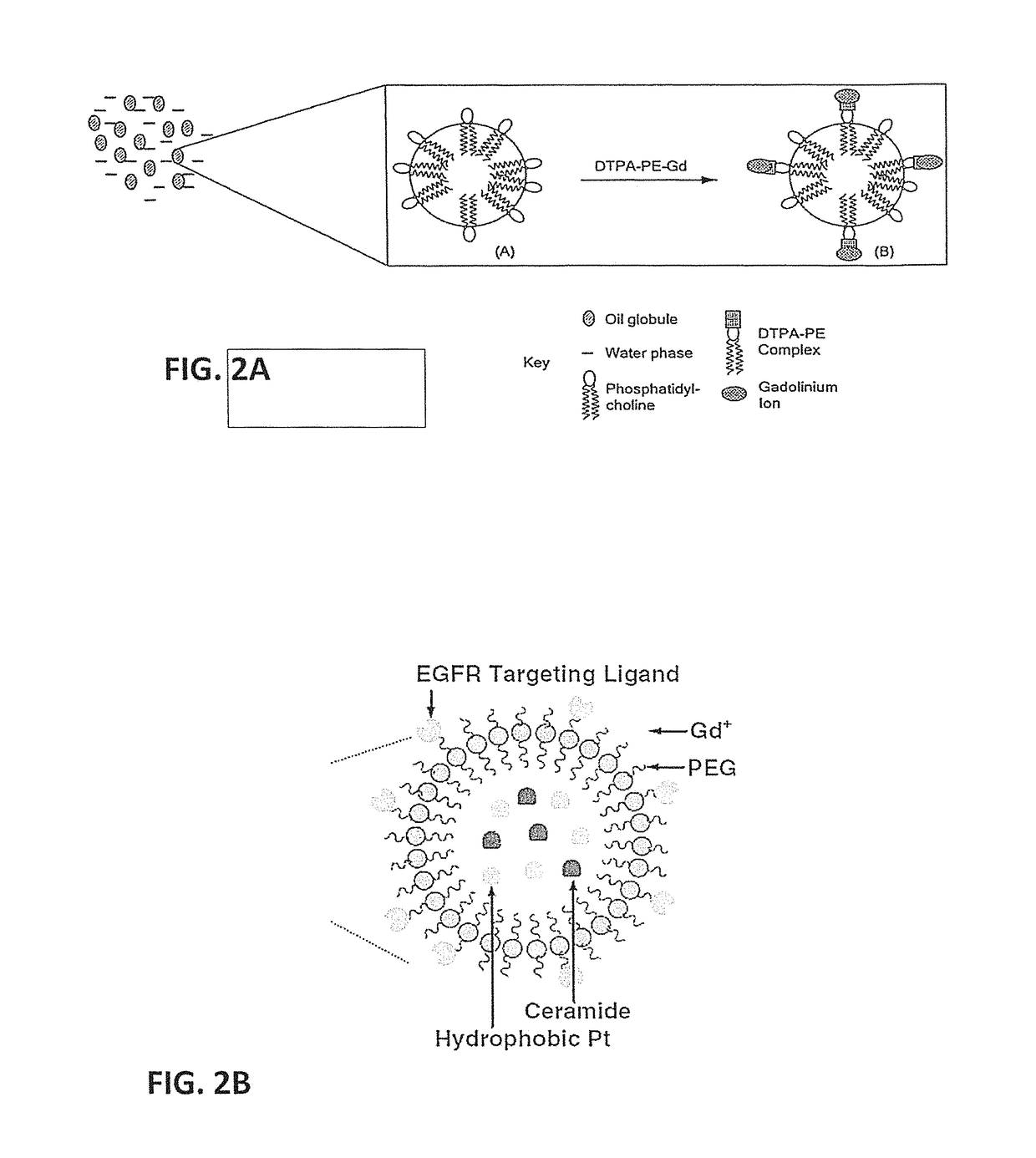Nanoemulsion compositions of taxoid drugs, and methods for the use thereof to target cancer cells and cancer stem cells
a technology of taxoid drugs and nanoemulsions, which is applied in the direction of drug compositions, oil/fat/waxes non-active ingredients, microcapsules, etc., can solve the problems of increasing the number of genomic and epigenomic changes, the success rate of current chemotherapeutic agents in development for prostate cancer is significantly lower than other cancers, and the stemness of cancer stem cells is reduced. , the effect of reducing the expression of stemness-promoting
- Summary
- Abstract
- Description
- Claims
- Application Information
AI Technical Summary
Benefits of technology
Problems solved by technology
Method used
Image
Examples
example 1
t PUFA-Taxoid Conjugate, DHA-SBT-1214, is Effective Against Both PX-Sensitive and PX-Resistant Tumors In Vivo
[0085]Effect of DHA-SBT-1214 on Growth of PX-Resistant Human Colon Cancer Xenografts in SCID Mice.
[0086]In experiments using the paclitaxel-resistant, Pgp(+) DLD1 human colon tumor xenograft implanted s.c. in SCID mice, paclitaxel and TAXOPREXIN® were totally ineffective. In sharp contrast, DHA-SBT-1214 caused complete regression of the DLD-1 tumor in 5 of 5 mice at the 80 mg / kg dose administered on days 5, 8, and 11 (tumor growth delay>187 days) (FIG. 3A).
[0087]Effect of DHA-SBT-1214 on the Growth of Human Pancreatic Cancer Xenografts in SCID Mice.
[0088]This experiment compared a q7dx3 with a q3dx3 schedule for PX and DHA-SBT-1214 using a human PANC-1 pancreatic tumor xenograft in RPCI SCID mice. The results (FIG. 3B) indicated that both schedules were very effective in this human pancreatic tumor xenograft (tumor growth delay>90 days). The maximum tolerated does (MTD) for D...
example 2
t Taxoid SBT-1214 Reduces the Stem Cell Properties of Cancer Stem Cells
[0094]Experiments were carried out with a patient-derived cancer stem cell line for prostate cancer, PPT2 (Botchkina 2013, Rowehl 2014). The cell line PPT2 was generated from a patient-derived prostate cancer tumor. Subcloning of these small-cell-containing holoclones led to dramatic enrichment of cells expressing high levels of CD133, CD44, CD44v6, EpCAM, CD49f and CD166. The PPT2 cell line was serially propagated as NOD / SCID mice tumor xenografts, floating 3D spheroids and type I collagen-adherent cultures. According to the ATCC report (ID number 002872), the PPT2 cells were unique human cells not contaminated with any known established cell lines. Although phenotype of the CSC-enriched cultures was dynamic due to the dual nature of the CSCs (i.e., ability to self-renew and to generate committed progenitors), the PPT2 cells retained a relatively stable phenotype, even up to 8 weeks after MACS-CD133+ cell sortin...
example 3
on of Formulations of NE-DHA-SBT-1214
[0101]The NEs of the present invention are simple colloidal carriers formed by dispersion of omega-3 -6 & -9 polyunsaturated fatty acid (PUFA) rich oils in water and stabilized with an amphiphilic phospholipid monolayer. Detailed descriptions of the compositions of these NEs, and methods of making them, are found in U.S. Patent Application Publication US20070148194 (2007) to Amiji, et al, NEs composed of oils rich in omega-3 PUFA have been found to enhance PX accumulation in SKOV3 cells.
[0102]Briefly, to formulate NE-DHA-SBT-1214, an oil-in-water NE formulation is prepared by a high energy microfluidization process. First, the aqueous phase is prepared by dissolving egg phosphatidylcholine and a pegylating agent (PEG2000DSPE) in deionized water. DHA-SBT-1214 is then added to PUFA rich oils to obtain the oil / lipid phase. The mixture is pre-homogenized for 5 cycles at low pressure with a MICROFLUIDIZER® processor M-110EH to form a coarse emulsion, ...
PUM
| Property | Measurement | Unit |
|---|---|---|
| mean droplet diameters | aaaaa | aaaaa |
| mean droplet diameters | aaaaa | aaaaa |
| diameter | aaaaa | aaaaa |
Abstract
Description
Claims
Application Information
 Login to View More
Login to View More - R&D
- Intellectual Property
- Life Sciences
- Materials
- Tech Scout
- Unparalleled Data Quality
- Higher Quality Content
- 60% Fewer Hallucinations
Browse by: Latest US Patents, China's latest patents, Technical Efficacy Thesaurus, Application Domain, Technology Topic, Popular Technical Reports.
© 2025 PatSnap. All rights reserved.Legal|Privacy policy|Modern Slavery Act Transparency Statement|Sitemap|About US| Contact US: help@patsnap.com



